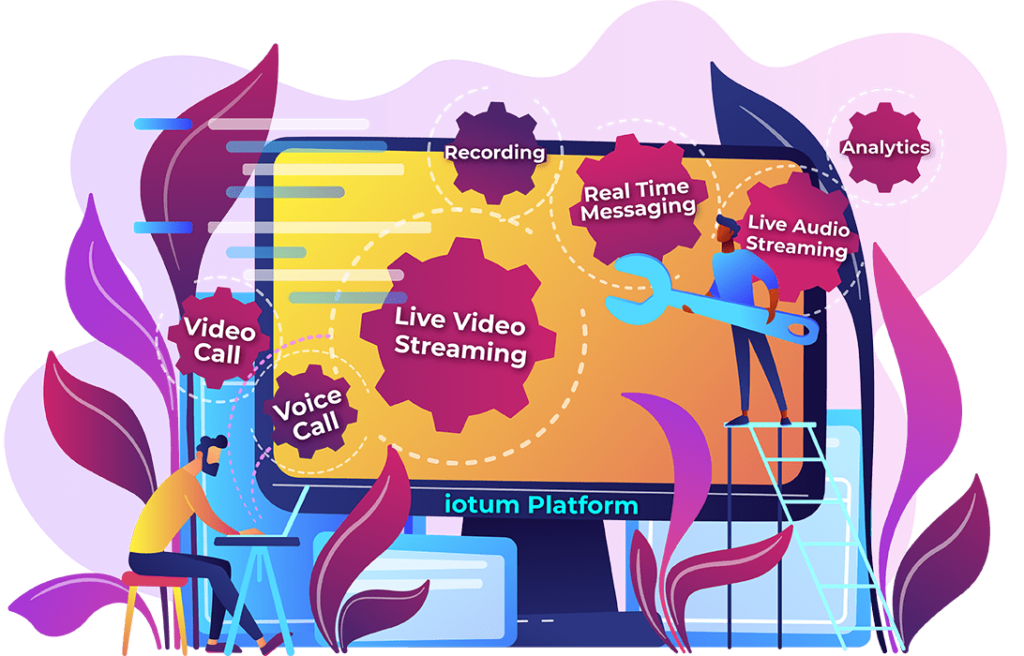 In recent years, telemedicine has emerged as a revolutionary solution that is transforming how healthcare is delivered.
In recent years, telemedicine has emerged as a revolutionary solution that is transforming how healthcare is delivered.
With the advancements in technology, including high-speed internet, telemedicine is becoming more affordable and accessible for everyone and is now widely adopted across the globe.
The main benefit of telemedicine is that it allows patients to connect with doctors or healthcare professionals remotely, breaking the barriers of time and distance. This makes healthcare more accessible and affordable for individuals who reside in rural/remote locations, elderly patients, or those with mobility limitations.
Thinking of starting a telemedicine service on your own? Then it’s definitely a great time. Telemedicine can be a lucrative business opportunity with enormous potential for success and positive change.
Yet, that doesn’t mean you’ll automatically achieve success, as venturing into this competitive field would require careful strategic planning and execution. A well-structured business plan can serve as a roadmap for success, guiding entrepreneurs through the complexities of starting and growing a telemedicine business.
In this article, we will discuss how to plan a telemedicine business for success. We aim to provide valuable insights and actionable steps for building a successful telemedicine service, which will include the following topics:
- Understanding telemedicine and its potential
- Planning a working telemedicine business model
- How to build a telemedicine infrastructure to ensure a running operation
- Regulatory and legal considerations for starting a telemedicine business
- Funding and financial projections
- Develop a marketing strategy
This article aims to equip aspiring entrepreneurs or professionals looking to tap into the thriving telemedicine market with the tools and knowledge necessary to achieve success, and without further ado, let us begin right away.
Understanding Telemedicine Business and Its Potential
Telemedicine, simply put, is leveraging telecommunications technology and digital platforms to deliver healthcare services remotely, connecting patients and healthcare providers irrespective of geographical limitations.
In its implementation, telemedicine can benefit both healthcare providers and patients, including but not limited to:
- Enhanced accessibility: telemedicine bridges the geographical barriers, making healthcare services accessible to patients in rural or underserved areas and allowing patients to access healthcare experts located in different cities or even countries.
- Convenience and flexibility: telemedicine offers a higher level of convenience by enabling patients to schedule appointments and consult with medical professionals from the comfort of their homes. This minimizes disruptions to their daily routine, reduces or even eliminates the need to travel, and reduces waiting times often associated with visiting hospitals or clinics.
- Improved patient engagement: telemedicine encourages patients to be more active and engaged, for example, by offering easy access to medical information.
- Cost-effectiveness: telemedicine can improve cost-efficiency for both patients and healthcare providers and reduces expenses related to infrastructure, administrative overheads, and especially travel.
- Better productivity for healthcare providers: telemedicine can improve the workflow of healthcare providers, enabling them to manage more patients in any given timeframe to improve overall efficiency.
Market Trends and The Potential for Growth in the Telemedicine Industry
The telemedicine market is growing rapidly and is still projected to continue growing. According to a report by Grand View Research, the global telehealth market size was valued at USD 83.5 billion in 2022 and is projected to expand at a compound annual growth rate (CAGR) of 24.0% from 2023 to 2030.
This growth is being driven by a number of factors, including:
- The global pandemic throughout 2020-2022 has accelerated the adoption of telemedicine in very significant ways. Both healthcare institutions and patients realized its benefits, and this trend in adoption is still continuing post-pandemic throughout 2024 and is likely to continue going forward.
- Rapid advancements in communication technology, IoT devices, wearables, and mobile devices are enabling more seamless digital interactions, capable of facilitating more sophisticated telemedicine solutions.
- Governments around the world are recognizing the value of telemedicine in improving healthcare access for more people and are implementing policies and regulatory changes to support its growth.
- The growing aging population all around the world demands more and better healthcare services. Telemedicine offers a viable solution to address the growing healthcare needs of the senior demographic.
As you can see, telemedicine represents a transformative force as a game-changer in healthcare delivery. With the technology advancements and a supportive market landscape, we can expect continuous remarkable growth of the telemedicine industry in the near future.
Crafting a Working Telemedicine Business Model
Having a well-defined business model lays the groundwork for the success of the telemedicine business.
In this section, we will explore the essential aspects of shaping a winning business model, from identifying the target audience to how to position your venture for optimal growth.
1. Identifying Your Target Audience
Thefirst step in crafting a telemedicine business model is to identify your target audience.
Who are you trying to reach with the telemedicine service? What are their specific needs? What are the pain points your telemedicine solution can solve?
Identifying and understanding your target audience and focusing on a specific area of expertise will allow you to tailor your services to meet your target audience’s needs.
Here is how you can do it:
- Market research: conduct comprehensive market research to understand the specific healthcare needs and preferences of different target demographics. Identify gaps and opportunities in the current telemedicine offerings, especially in areas with high demand for healthcare/telemedicine services.
- Patient persona: create a semi-fictional patient persona that represents your ideal target audience. Make it as detailed as possible while considering factors such as location, age, medical conditions, and so on. The idea is to tailor your telemedicine service to this patient persona’s specific needs. Create multiple personas if necessary.
2. Choosing a Specialization
Telemedicine, as we’ve discussed, encompasses a wide range of services. Choosing the one that aligns with your target audience is essential for success.
Is there an opportunity to offer specialized telemedicine services? For example, you may decide to offer services in areas such as mental health, chronic disease management, dermatology, women’s health, etc.
Focusing on a specifically targeted niche may help you attract a more loyal customer base.
Different Types of Telemedicine
Telemedicine can come in various forms and utilize a wide range of different technologies (audio, video, text-based, etc.), but we can categorize them into four major types.
- Synchronous telemedicine: this type of telemedicine offers real-time and two-way interactions between patients and healthcare providers, akin to a traditional face-to-face appointment. To allow these real-time interactions, typically, video conferencing or telephone conversations are involved.
- Asynchronous telemedicine: in this type of telemedicine, the communication between patients and healthcare providers happens non-simultaneously. For example, the patient can send their medical information via email, then the healthcare provider replies to the email a few minutes after. Besides email, asynchronous telemedicine can happen over chat/messaging or file (i.e., image) sharing platforms.
- Remote patient monitoring: or RPM, this type of telemedicine leverages IoT devices and wearables to allow healthcare professionals to monitor patients’ health parameters and vital signs remotely.
- Mobile Health (mHealth): mHealth, short for Mobile Health, refers to leveraging mobile devices (and also wearables) to provide health services, including health tracking, medication reminders, and remote/virtual consultations.
Based on the chosen niche, you should choose a type of telemedicine service that aligns with this niche and the target audience.
3. Competitive Analysis and Positioning Your Venture In the Market
Identifying and understanding your competitors is vital for success, enabling you to differentiate your telemedicine venture in the market.
You can follow these steps:
- Competitor analysis: identify and research other telemedicine providers (or indirect competitors) in your niche. Try to understand their market share and strengths and weaknesses. Identify opportunities to improve existing services or offer something unique.
- Unique Selling Proposition (USP): based on your competitor analysis results, determine your telemedicine venture’s USP —what sets your telemedicine service apart from your competitors. Is it a lower price? Exceptional customer service? User-friendly platform? Specialized expertise? Or others.
- Brand messaging: clearly communicate your telemedicine service’s unique value. Consider the benefits you can provide for both the patients and healthcare providers, such as cost savings, improved access to healthcare, improved convenience, and more. Craft compelling brand messaging that communicates your business’s mission and core values.
4. Pricing Strategies and Revenue Streams
How can a telemedicine business make money?
There are a number of potential revenue streams options for a telemedicine business:
- Direct patient payments: Simply put, patients pay a fee for each telemedicine consultation (or each telemedicine service used). This is the most common revenue stream for a telemedicine business. We can consider this a pay-per-use model.
- Subscription: patients pay a monthly or annual fee for access to your telemedicine service.
- Advertising: you can offer businesses or other people to advertise their products or services on your telemedicine platform. This can be an ideal revenue stream when you already have a large user base.
- Data monetization: as your telemedicine service collects more data about your patients, you can sell this data to other businesses or leverage it to develop new products or services. However, keep in mind that in the healthcare industry, patient data privacy is heavily regulated.
- Partnerships: for example, you can partner with a company to offer telemedicine services to its staff or with an insurance company to offer your services to its members.
You can choose one or more revenue streams depending on your niche and your target audience, and based on this revenue stream model, you should establish your pricing strategy.
How much you should charge your service would depend on a number of factors, like your location, target audience, the services offered, and the competition. Yet, make sure to consider your cost for providing the telemedicine service to ensure profitability.
Regulatory and Legal Considerations
The healthcare industry is a heavily regulated industry, so launching a telemedicine venture would naturally involve navigating complex legal and regulatory considerations.
This section discusses crucial aspects you should address to operate a legally compliant telemedicine business:
- Licensure: in most states and countries, businesses providing telemedicine services must be licensed in the state where the patient is located.
- Practice guidelines: each set has its own set of telemedicine practice guidelines that you should follow, but they typically address issues such as the types of services allowed to be provided through telemedicine, the technology that could be used, and the patient’s informed consent process.
- Data privacy and security: it’s critical to ensure that patient data sent or received is protected in accordance with HIPAA regulations.
The legal and compliance landscape for telemedicine is constantly evolving, so it’s critical to keep yourself up-to-date on the latest requirements. Also, train your team, staff, and healthcare providers on data privacy protocols and compliance measures to maintain the best practices, especially in ensuring data privacy and confidentiality of patient information.
Building The Telemedicine Infrastructure
In this section, we will discuss how to build a robust telemedicine infrastructure as the bedrock of your business.
A reliable and efficient and HIPAA compliant telemedicine video API would include at least the following elements:
- High-quality video and audio: the majority of telemedicine implementations would involve video/audio communications. Thus, the video and audio quality must be decent enough to ensure effective and clear communication.
- Secure data storage: robust data storage with encryption and strict access control is crucial to properly safeguard patient information.
- HIPAA compliance: ensure compliance with HIPAA and other relevant healthcare regulations.
- Reliable connectivity: the telemedicine platform must be able to provide reliable and secure connectivity, even in areas with limited internet speed.
- User-friendly interfaces: it’s crucial for the telemedicine platform to have intuitive and user-friendly interfaces that are easy to use by both healthcare providers and patients to ensure a high adoption rate.
Integrating Audio/Video Conferencing Solution to Your Telemedicine Platform
Audio/video conferencing is a very critical component of any telemedicine platform, and you basically have three options on how to make this critical feature available on your telemedicine solution:
- Building from scratch: if you have the skills/experience or the budget to hire an experienced developer, then building audio/video communication functionality from scratch will give you the most freedom and versatility.
- Integrating free/affordable video conferencing solutions: the second option is to use ready-made solutions like Zoom or Google Meet. A lot of these solutions are free or very affordable, and many are very dependable. However, you’ll get the least freedom in customizing your platform, including adding your branding elements.
- Integrating white-label video conferencing solutions: professional white-label video meeting solutions Iike Iotum offer the best of both worlds, bypassing the time and cost otherwise needed to develop your solution from scratch and yet giving you more freedom to customize your platform.
Among these available options, Iotum emerges as a standout, cost-effective choice for elevating your telemedicine platform. Iotum offers a comprehensive solution to ensure data security, ease of use, and seamless integration with existing healthcare systems and medical devices.
Integrating Iotum’s video conference API into your platform would allow you to provide both healthcare providers and patients with a secure, seamless, and reliable communication channel to enhance the healthcare experience.
Developing a Marketing Strategy
No matter how good your telemedicine platform is, it won’t be a successful venture if you can’t attract enough users or clients to use the platform.
You’ll need an effective marketing strategy to attract and retain both patients and healthcare providers, establish credibility in the competitive market, and build brand awareness.
Below, we’ll cover how to develop a marketing strategy for your telemedicine business.
Creating a compelling brand identity
Develop a strong brand identity that resonates with your target audience and aligns with your core brand message.
A strong brand identity that is easy to remember is crucial for distinguishing your telemedicine solution and resonating with your target market.
Consider the following brand identity elements:
- Mission and values: define your telemedicine business’s mission and core values. Craft a clear, concise, and impactful mission statement that can engage your target audience.
- Name: choose a name that is unique but easy to pronounce and remember. Your brand name should reflect your business’s values and mission.
- Logo and visual identity: design a professional logo and visual elements that align with your brand name and message and can represent your brand’s personality.
- Brand voice: decide on a consistent brand voice that reflects the personality and tone of your telemedicine business. Speak your target audience’s language (i.e., don’t be too technical), and try to be empathetic and reassuring.
- Patient-centric approach: as a telemedicine venture, highlight your patient-centric approach in all marketing materials and communication. For example, emphasize that your telemedicine service prioritizes patient well-being and convenience.
Choosing the right marketing channels
There are a number of marketing channels (both online and offline) you can leverage to raise awareness about your telemedicine platform and reach your target audience.
Here we will discuss some of the most popular and effective ones you should consider.
Digital channels:
- Your website: create a professional-looking, user-friendly, and fully functional website that can effectively showcase what your telemedicine platform offers and communicate your unique selling points clearly.
- Search Engine Optimization (SEO): optimize your website with relevant keywords and technically optimize it to improve its search engine ranking and drive organic traffic.
- Social media marketing: build a strong presence on popular social media platforms (Facebook, LinkedIn, Twitter, Instagram, etc.) and share relevant content to establish rapport and promote your telemedicine service. Consider investing in paid advertising options offered by these social platforms.
- Display advertising: invest in targeted online advertising, for example, via Google Ads to reach potential audiences based on demographics, behavior, interests, or other factors.
- Email marketing: build an email list of prospective users and existing patients/healthcare providers. Send educational content, updates regarding your platform, and exclusive promotions regularly to keep them engaged and nurture relationships.
Offline channels:
- Direct mail: consider sending targeted direct mail, for example, to hospitals or doctors to introduce your telemedicine service and its benefits.
- Community events and health fairs: participate in or host health fairs, community events, medical conferences, or other events to network with potential patients and healthcare professionals and build awareness.
- Local partnerships: collaborate with clinics, hospitals, pharmacies, local healthcare providers, or other relevant businesses to offer cross-promotional initiatives.
- Traditional advertising: consider advertising your service in local newspapers, magazines, healthcare publications, radio stations, billboards, or TV channels to reach a broader audience. This is especially effective if you are promoting to regions where traditional media is still popular.
Conclusion
This guide has discussed how to plan a telemedicine business venture to ensure success.
By following the actionable tips and strategies in this article, you have equipped yourself with the tools and knowledge needed to make a positive impact on providing healthcare accessibility to more people.
As you embark on the journey of starting or growing your telemedicine business, remember the fact that telemedicine is continuously evolving. Stay updated on the latest trends, keep your business agile, adapt to new innovations, and embrace emerging technology to stay competitive.

